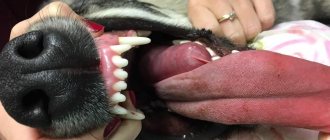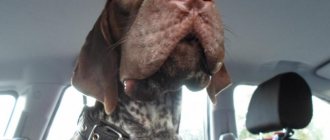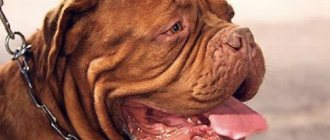Colitis in dogs is a pathology that is accompanied by a number of symptoms characteristic of dysfunction of the digestive tract. Depending on the type of disease, a treatment regimen is selected and adjustments are made to the pet’s diet.
The large intestine of dogs consists of the cecum, colon and rectum - this is the final section of the digestive system. As a rule, any deviation of the gastrointestinal tract is accompanied by malfunctions in each department of the system. Therefore, it is important to treat all pathologies, starting with the oral cavity, immediately and fully.
What is colitis in a dog?
Colitis is an inflammation of the lining of the large intestine in a dog. This department performs the following functions: barrier, peristaltic, absorption of salts and liquids, digestion, formation and evacuation of feces.
On the surface of the mucosa there are cells that constantly analyze the contents of the intestine. In the process, local inflammation may develop, which normally resolves quickly. With colitis, the barrier function of the intestinal mucosa is disrupted, an inadequate immune response to its own bacterial microflora, feed components, etc. occurs. Most of the intestine is affected, digestion and absorption are impaired.
The disease begins to manifest itself in adult animals. No gender predisposition was identified.
Types of disease
Depending on the pathogenetic characteristics, the disease can be of the following types:
- Lymphocytic-plasmacytic colitis in dogs is accompanied by infiltration of the intestinal mucosa by inflammatory cells: lymphocytes and plasmacytes. This is the most common form of the disease.
- Hemorrhagic. This type of colitis is accompanied by ulcerations of the mucous membrane. Blood clots are observed in the stool and pain is noted.
- Eosinophilic ulcerative colitis in dogs can develop as an allergic reaction to foreign proteins (food or parasites). Usually the process also involves the small part and stomach.
- Spastic colitis is accompanied by painful spasms of the large intestine. Signs of such inflammation are diarrhea and tenesmus.
According to the nature of the course, inflammation is divided into:
- Acute colitis. Develops when the mucous membrane is exposed to highly toxic (pathogenic) components. In acute cases, obvious symptoms persist for up to 7 days.
- Chronic. If symptoms persist for more than 7 days. Improvements in the condition may be observed periodically. This type of inflammation is observed with constant exposure to unfavorable factors (neoplasms, helminths, dysbacteriosis).
Expressive symptoms
How to find out that your pet has colitis and not another disease?
- Diarrhea. Due to inexperience, many owners often confuse it with constipation. Since little feces come out, the animal seems to be unable to relieve itself. All this is accompanied by excrement of blood and mucus.
- Diarrhea is a protective reaction of the body to the manifestation of illness or poisoning. Thus, the stomach tries to get rid of foreign bodies. But, due to the fact that the nervous system has little control over this process, without proper treatment the dog may simply die.
- Vomit. The pet refuses food and begins to eat grass intensively. This causes colitis to develop even more severely, since the stomach cannot digest such a large amount of food and everything comes out through the mouth.
For what reasons can a dog have colitis?
The disease develops for various reasons:
- Nutritional. Reaction to food (of any quality), excessive consumption of vegetables, overeating, etc.
- Infectious (parvovirus, hepatitis, plague, parainfluenza).
- Damage to protozoa (pyroplasmosis, coccidiosis, giardiasis).
- Bacterial and fungal infections.
- Toxic: poisoning by chemicals, poisonous plants and products.
- Mechanical: foreign body, strangulation (strangulation of the intestinal lumen by something), intussusception (when part of an organ is inserted into the lumen of another).
- Chronic diseases of various parts of the gastrointestinal tract.
- Dysbacteriosis of any part of the intestine.
- Neoplasms.
- Helminth infestation.
- The following breeds are believed to have a genetic predisposition to the disease: Irish Setter, Basenji, Boxer, French Bulldog, Shar Pei, German Shepherd.
Forms of the disease
Colitis can occur in three forms: acute, chronic and ulcerative:
- Acute colitis lasts from 2-3 days to 2-3 weeks, the symptoms are pronounced. This form is usually the result of feeding disorders (the dog eating spoiled foods, etc.), stress, or taking certain medications.
- Chronic colitis is a complication of the acute form of the disease. It can develop for various reasons: entry into the gastrointestinal tract of a foreign body, infection with helminths, bacterial infection. With this form of colitis, exacerbations are periodically observed, during which all the symptoms are pronounced (diarrhea, rumbling, nausea, etc.).
- Ulcerative colitis occurs in a chronic form. The exact reasons for its development are unknown, but this disease is typical for dogs of the German Boxer breed. It is believed that there is a genetic predisposition to ulcerative colitis.
Symptoms of disease in an animal
The main symptoms of colitis in a dog:
- diarrhea is a leading sign of intestinal damage;
- vomit;
- gradual loss of body weight;
- decreased appetite;
- flatulence and rumbling in the stomach;
- foul odor from the mouth;
- decreased activity;
- pain in the abdominal area;
- melena - black unformed feces;
- tenesmus - the dog assumes a posture for defecation, but no feces are released;
- jaundice (with concomitant liver damage);
- ascites;
- increased salivation.
Main symptoms of the disease
The main symptom of any form of colitis is stool disorder, and blood and mucus are often present in the feces. The consistency of stool is mushy or liquid.
Here are other signs of the disease:
- the dog experiences pain during defecation;
- belching is observed;
- rumbling is heard in the intestines;
- the pet suffers from flatulence;
- the dog periodically vomits;
- a grayish coating appears on the tongue;
- during periods of exacerbation, body temperature may increase;
- an unpleasant odor appears from the mouth;
- The pet loses body weight and eats poorly.
In acute colitis, the animal experiences pain in the intestines and colon, often attempts to defecate, but the output of stool is small. The pet emits gases, burps, and urinates frequently. In the summer, the dog actively eats fresh grass, after which vomiting is observed.
Attention. With chronic colitis, the symptoms are not so pronounced. The dog eats poorly and loses body weight. The consistency of the stool is constantly changing, and diarrhea is usually causeless.
With ulcerative colitis, frequent bowel movements are observed (up to 6 times a day), and the feces are liquid and contain a large amount of mucus and blood. As the disease progresses, animals lose weight and develop anemia due to dehydration. Ulcers form on the colon mucosa.
Diagnostic methods
When making a diagnosis, all clinical manifestations of the disease and medical history are taken into account. To identify the cause of inflammation, the following is carried out:
- Laboratory diagnosis of stool: clinical analysis, as well as analysis for helminths, protozoa, bacteria (culture may be required).
- Taking venous blood for general and biochemical tests.
- X-ray allows you to evaluate the topography of internal organs, as well as exclude (or confirm) the presence of a foreign body.
- Ultrasound examination of the abdominal organs.
- Diagnostic laparotomy is a last resort measure, carried out if all of the listed diagnostic methods do not reveal any pathology. As a result of surgical intervention, the doctor can directly assess the condition of the internal organs and understand the cause of colitis.
- Biopsy of the intestinal mucosa and histological examination of the obtained material.
Treatment of colitis in dogs
Treatment of colitis comes down to alleviating the symptoms of the disease and eliminating the cause that led to the development of inflammation of the intestinal mucosa.
In acute cases, a fasting diet is recommended on the first day. The pet is allowed only liquid; enterosorbents are prescribed if necessary. At home, as an additional treatment, it is permissible to give your pet decoctions of chamomile and oak bark. Sometimes solutions are administered through the rectum in the form of an enema.
► Antiparasitic drugs are prescribed twice (sometimes three times) with an interval of 14 days. Anthelmintics for dogs are represented by means that can be used internally (tablets, suspensions) or drops on the withers. Examples of drugs:
- Drontal.
- Fenbendazole.
- Prazicide.
- Stronghold.
- Milbemax.
► The course of anti-inflammatory drugs is selected individually only on the recommendation of a veterinarian. Prednisolone is usually used in the form of injections or tablets at a dosage of 1-2 mg/kg 2 times a day.
► The use of sulfasalazine in the treatment of colitis in animals is possible in chronic cases. The drug passes intact through the entire digestive tract and begins its anti-inflammatory effect only in the large intestine. Due to a number of side effects, the drug is used with caution.
► Antibacterial drugs for inflammation of the colon mucosa are mainly prescribed:
- Metronidazole is given orally, 2 times a day. The dosage is prescribed by the veterinarian. The drug is also effective if the dog's colitis is caused by protozoa.
- Tylosin 50 in the form of intramuscular injections for 7-10 days.
► With prolonged diarrhea and vomiting, dehydration develops. To stabilize the condition, animals are given intravenous infusions of isotonic solutions (sodium chlorides, glucose 5%). If necessary, vitamins and amino acids are added to the dropper.
► To restore beneficial microflora, the dog is given Vetom and Lactobifadol with food or water.
The prognosis for colitis in dogs is generally favorable. In the chronic form, much depends on the owner. Strict adherence to the diet is required, and for some animals, lifelong therapy.
Diet
An important requirement for the nature of feeding is to increase the frequency of feeding while reducing portions.
After following a starvation diet, the pet begins to be fed foods with high digestibility. The fat content is reduced, but not completely eliminated. With the natural type of feeding, the products are crushed into small pieces. For small breed dogs, it can be brought to the consistency of a pate. Turkey, chicken, and rabbit are given as a source of animal protein. If your pet has diarrhea, add rice or rice water. Soluble fiber is added as a substrate for beneficial intestinal microflora.
With the industrial type of feeding a dog with colitis, veterinary medicinal foods are prescribed:
- Royal canin gastrointestinal.
- Royal canin Digestive care.
- Hill's prescription diet I/D.
- Pro Plan veterinary diets Obesity or Gastrointestinal.
When feeding veterinary diets, it is important to follow the following rules:
- For the entire duration of treatment, it is necessary to exclude all other food sources (treats are also prohibited).
- Follow the recommended daily dosage of food indicated on the manufacturer's packaging.
- The dog should always have free access to drinking water.
- The duration of feeding with medicinal food is about 2 months. In some cases, the diet may be prescribed for life.
- The transition to regular everyday food is carried out gradually over 10-14 days.
Expert opinion
Kuzmenko Olga Olegovna
Information about the expert
Ask a Question
When choosing regular food after treatment of colitis, it is recommended to choose diets for animals with sensitive digestion.
Useful video on the topic: what is colitis in a dog? Its symptoms and treatments
How is the disease treated?
Colitis is treated with two drugs: Loperamide (Imodium, Lopedium, etc.) and Sulfasalazine. Be sure to prescribe a starvation diet for 1-2 days (in acute forms of the disease), and then add foods to the dog’s diet that normalize the formation of feces (bran, etc.).
The drug Loperamide relieves pain in the colon and improves the general condition of the pet, but since it does not have an anti-inflammatory effect, the symptoms of the disease return after stopping the treatment. Inflammation of the mucous membrane is relieved with Sulfasalazine.
If colitis was caused by helminths or other parasites (dipylidiasis in dogs, etc.), antiparasitic drugs are used for treatment: Milbemax, Drontal, Kanikquantel, Tinidazole, etc. Levomycetin, Febendazole, etc. are used to fight infection and bacteria.
Loperamide and Sulfasalazine are used to treat colitis
The most difficult form of colitis to treat is ulcerative colitis. In this case, lifelong use of hormonal corticosteroid drugs and periodic administration of sulfasalazopyridazine are prescribed. Enrofloxacin will help improve the well-being of your pet with ulcerative colitis.
Prevention methods
- Timely deworming of the animal (once per quarter). Drugs are selected strictly according to the dog’s weight.
- Annual pet vaccination at any age.
- Feeding the dog high-quality food, following the regime.
- Do not treat your pet with food from the table: flour, sweets, fatty, smoked, etc.
- Hide household chemicals and other harmful substances out of reach.
- Strict control during the walk, make sure that the dog does not pick up anything from the ground or eat the feces of other animals.
- Don't give your dog long bones.
- Transfer your pet to a new type of food smoothly. Over the course of several days, add a small portion of the new diet to the old diet, gradually changing this ratio.
Colitis in dogs is a problem that every owner can face. The disease occurs even with proper feeding and in some cases has a genetic predisposition. You should consult a doctor if your pet has frequent episodes of indigestion. The veterinarian will tell you how to treat colitis and prescribe a diet to improve bowel function.
Signs of colitis
The main sign of this disease is your pet's extreme thirst. Of course, you shouldn’t be alarmed if your dog drinks a lot of water after a walk. It `s naturally. Colitis can occur in both the acute and chronic phases. Experts advise paying attention to feces every time you take your pet for a walk. After all, one of the main signs of colitis is the presence of bloody or mucous spots in the stool.
Defecation in a pet with colitis exhibits a spasmodic character. The frequency of bowel movements also increases up to 5-7 times. Acute colitis is usually short-term, on average from 2 to 4 days, including remission. With a chronic disease, the phase can last up to 3 weeks and be accompanied by rapid weight loss in the pet. In rare cases, the first signs of colitis may be accompanied by vomiting.










